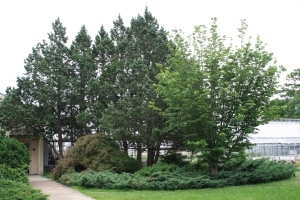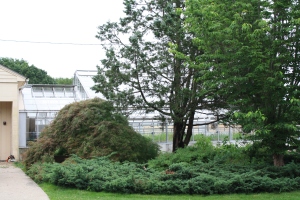
It was all about the rhododendrons and azaleas in May, but now comes the glorious reign of the Queen of Flowers — the peony.
Peonies have been cultivated for thousands of years. In China they are known as the “flower of riches and honor”. In ancient Greece, they were believed to have been obtained by Paeon, physician to the gods, from the mother of Apollo on Mount Olympus. In the European and American “Language of Flowers”, which emerged during the Victorian era, they symbolized happy marriage, compassion, and bashfulness. I think of them as anything but bashful!

I think it’s the fragrance that wins me over. Like roses, but somehow better than roses…sweet and smelling of summertime. Of course the blossoms are spectacular too! Most of the herbaceous or garden peonies grown today are hybrids of either Paeonia lactiflora or Paeonia officinalis. There are hundreds of cultivars. The flowers can be single or double. The colors range from white to pink to red and even to yellow. The newest innovation in peony breeding is a cross between herbaceous and tree peony types. Herbaceous peonies die back in winter, regrowing in spring, while tree peonies lose their leaves in winter, but leave woody stems. The cross “Intersectional” peonies have the leaf and flower form of the tree peony but die back, and have a bush growth habit like herbaceous peonies.

A frequent comment from visitors leaning in to admire the peonies is about the ants climbing busily all over the buds. Why are they there? Are they bad for the plants? And less frequently: Do they help the plants? Here’s an answer from the Heartland Peony Society based in Kansas City, Missouri :
“Peonies and ants: Talk about ‘Old Wives Tales’ ! Peonies in general do NOT attract ants, but some peony flower buds do. Do not try to get rid of the ants on your peonies. This is a natural and temporary activity. It is believed that peonies produce small amounts of nectar and other ant attractants to encourage ants to help in opening the dense double flower buds found in many peonies. The ants may be found covering certain varieties and avoiding others, this is totally normal.
Once the buds have opened the ants will disappear – also normal.Some people think ants are REQUIRED to open the flowers, but this does not to appear to be true.It seems a debatable question whether ants are beneficial or harmful. I think they are neutral.
Should you spray a pesticide to get rid of the ants? That is a definite no. Since the ants are not harmful and some pesticide residues are harmful, why endanger yourself, the plants or the peony’s pollinator (good insects) with poisonous sprays? Instead just enjoy the unique interaction of ants and peonies; an evolutionary effect thousands of years in the making and posing no problems in the long run.”

These beautiful plants are easy to grow. They are hardy from USDA zone 8 to zone 2. They do best in full sun, and prefer soil rich in organic matter , with an ideal pH of 6 to 7. That said, they are tolerant of a wide variety of soils as well as drought tolerant once established. Once they are established, peonies prefer not to be moved, and can go many years without being divided.
Saturday evening as I left the garden, there were two peony buds beginning to open along the walkway into the greenhouse. This morning when I looked, there were 22 fully open flowers! Like many things in the garden, peony time can be fleeting, depending on the weather. They don’t mind the heat, but rain beats them down rather quickly. The peonies here are mostly the old fashioned double varieties that need to be staked–the flowers are huge, too big to be supported by the stems. So I have them all staked, a labor of love, and they are beginning their spectacular display. In addition to the walkway, they are on the stage, along the west side of the Rose Garden, and behind the CE Outreach Center in the Kathy Mallon Garden. Come and see them, breathe deeply, and let summer begin!
















